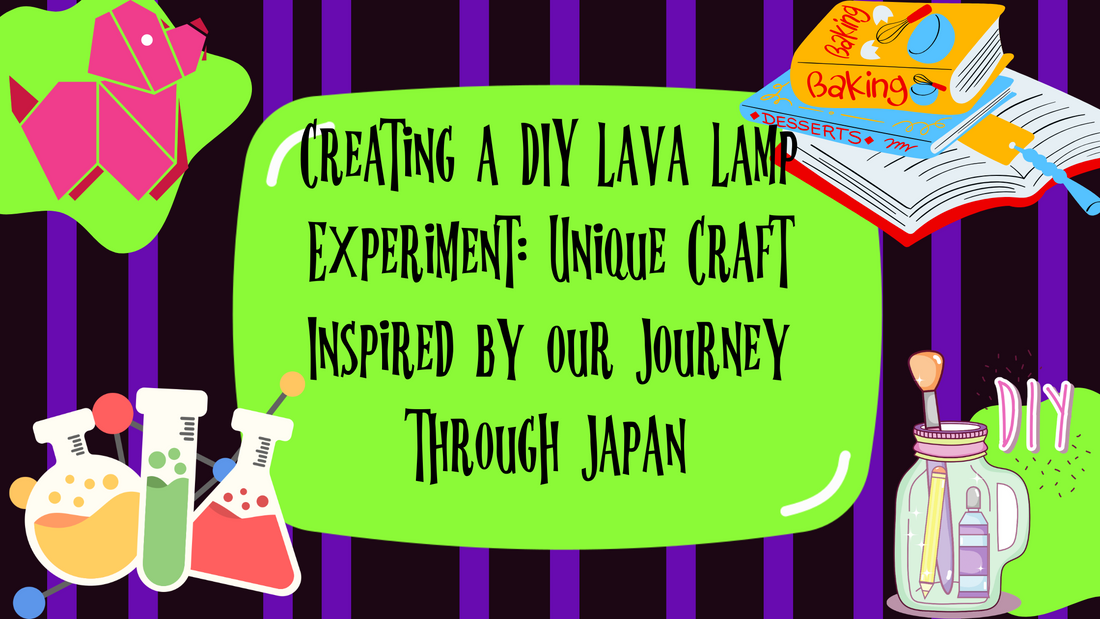As an affiliate, I earn from qualifying purchases, but this doesn't affect the reviews or recommendations—your trust is important to me!
Exploring : Create Your Own DIY Lava Lamp Science Experiment

Today, We're Making:
- - DIY Lava Lamp Experiment
- - Self-Watering Plant System: Using old water bottles, cotton or wool fibers, and a little bit of engineering, kids can build a self-watering plant system. This project teaches them about the water-cycle, environmental conservation.
Our Kitchens: More than Just a Place for Cooking
Our kitchens are more than just a place for cooking food. They can also be an improvised laboratory, a gateway to a galaxy of enthralling STEM activities for our enthusiastic young scientists.
DIY Lava Lamp Experiment At home
Have you ever thought of making a DIY Lava Lamp Experiment right at your home? Oh, yes! You heard it right! By using simple ingredients already sitting in your cupboard, you can create an exciting science DIY idea, right in the comfort of your home.
The Magic of Homemade Lava Lamp
This homemade lava lamp not only provides educational fun for both you and your kids, but it also offers a hands-on experience with the wonders of science. So, brace yourself, aspiring scientists! Today we dive into the magical world of At-Home Science and learn how to create a mesmerizing DIY Lava Lamp and fill our abodes with the vibrant colors of curiosity, creativity, and interactive learning.
Gathering Your Ingredients for the DIY Lava Lamp Experiment
This journey into the realm of Kitchen Science has a rather humble beginning. The list of things you would need for the DIY Lava Lamp Experiment couldn't be more straightforward. As we embark on this Indoor Science Activity, make sure you gather the following items which are easily available in your household:
- A clear glass or plastic container
- Vegetable oil
- Water
- Food coloring (feel free to mix and match hues for spectacular results)
- Effervescent tablets (like Alka-Seltzer)
While the DIY Science Lab setup might seem minimal, in reality, it opens a portal to a realm of exciting Science Lessons.
The DIY Lava Lamp Science Experiment Step-by-Step Guide
Your Science Lab at Home is all set for action! Here's your step-by-step guide to create your very own Homemade Lava Lamp.
Start with filling a third of your container with water, following which pour the vegetable oil until it reaches nearly the top of your container. You'll immediately notice the oil floating up, a visual demonstration of the Oil and Water Experiment. What just happened is your first brush with the concept of density! Isn't that an interesting part of At-Home Science?
Next in this Fun Science Activity, add a few drops of food coloring of your choice. You'll see that the food coloring drips through the oil and mixes with the water. Remember, food coloring is water-based, and hence, it doesn't mix with oil.
The final step in this Easy Science Project is dropping one effervescent tablet in your nearly ready DIY Lava Lamp and witness the magic. You'll observe small colored blobs rising from the bottom of the container to the top, resembling a lava lamp in action. That's your Homemade Lava Lamp casting its vibrancy in your home.
Intertwining Learning through Play, the DIY Lava Lamp Experiment imbibes foundational scientific principles in a fun-filled manner. You could think of it as the Kitchen Science equivalent of eating your cake (or should I say 'Lava Lamp') and having it too! It's moments like these when you make your own Lava Lamp, watch it in action, that you realize Science DIY Ideas like these truly embody the essence of Learning Science through Experiments.

DIY Lava Lamp Experiment: Kitchen Science
And there you have it, curious minds and science enthusiasts! Turning your kitchen into an impromptu laboratory with a fun, engaging, and educational DIY Lava Lamp experiment. By just using household materials, we've managed to transform an ordinary afternoon into an extraordinary universe of exploration.
So the next time you spy those seemingly mundane items in your cupboard, remember, with a sprinkle of curiosity and a dash of creativity, you can create magical science moments right at home.
This journey doesn't end here, though. Continue to fuel your thirst for knowledge and never stop exploring the wonderful world of kitchen science. After all, becoming a scientist starts at home. So here's to creating more vibrant mountains of delightful discovery, one DIY Lava Lamp at a time!

You May Also Like These:
DIY Project: Self-Watering Plant System
Ingredients:
- Two plastic water bottles, one small enough to fit inside the other
- Peat moss or sand based soil
- Rope or wicking material
- Cotton thread (Optional)
- Plant seeds of your choice
- Water
Instructions:
Step 1: Prepare the bottles
- Clean both bottles and remove any labels.
- Cut the top off the smaller bottle, this will be your planting pot.
- In the cap of your smaller bottle, make a hole.
Step 2: Prepare the wicking
- Cut a length of rope or wicking material a few inches longer than the height of your larger bottle.
- Thread one end of the rope up through the hole in the cap of the smaller bottle.
- If the hole is too small, use a cotton thread to thread the wick through the hole in the cap.
Step 3: Assemble the watering system
- Put the smaller bottle (with the wick) inside the larger one.
- Make sure that the wick reaches the bottom of the larger bottle, so it can soak up water.
Step 4: Plant the seeds
- Fill the smaller bottle with your peat moss or sand based soil.
- Plant your seeds in the soil according to their planting instructions.
Step 5: Add water
- Fill the larger bottle with water, taking care not to overfill.
- The water should be able to reach the wick. This will allow the soil to be moistened as the water travels up the wick.
That's it! You have created a self-watering plant system.
DIY Aquarium STEM Project for Kids
The DIY Aquarium project is a fun, interactive and educational project that teaches kids about underwater ecosystems. Here’s a step-by-step guide to help you and your child create a DIY Aquarium.
Materials Needed:
- Vase or a clear container
- Pebbles or aquarium rocks
- Plastic aquatic plants
- Aquarium decor
- Tap water
- Aquarium fish (optional)
Instructions:
- Gather all the required materials: The first step is to gather all the necessary materials needed for the project.
- Prepare the Vase: Clean the vase thoroughly and set it on a flat surface.
- Add the Pebbles: Now, ask your child to gently spread the pebbles or aquarium rocks on the bottom of the vase.
- Arrange the Plants and Decor: Let the child's creativity flow as they arrange the aquatic plants and the aquarium decor inside the vase.
- Fill the Vase With Water: Slowly fill the vase with tap water.
- Add the Fish: If you have decided to add aquarium fish, do so now. However, remember that a small vase can only support one or two small fish.
- Observe and Enjoy: Once the DIY Aquarium is complete, kids can observe and learn about the underwater ecosystem. Make sure to replace the water every week.
Safety Measures:
- Always supervise children when working with water and small objects.
- If you decide to add fish, treat them responsibly and ensure they are properly cared for.
STEM Project: Build Your Own Telescoping Grabber
Ingredients
- 2 PVC Pipes: One should be able to slide inside the other comfortably.
- String: A good strong piece, at least twice the length of your longest PVC pipe.
- 2 Small Rubber Bands: These are going to act as your grip, so make sure they are tough!
- Tape: To secure the string to the pipes.
- Scissors: For cutting the string to the correct length.
Instructions
- Step 1: Thread one end of the string through the larger PVC pipe.
- Step 2: Pull the string out of the other end and tie the two rubber bands to it.
- Step 3: Slide the smaller PVC pipe inside the larger one, the rubber bands should be sticking out of the end of the smaller pipe.
- Step 4: Tape the other end of the string to the outside of the larger PVC pipe. Make sure it's secure!
- Step 5: Pull on the string to open the rubber bands, release to let them snap shut. You now have a telescoping grabber!
Self-Watering Plant System - A STEM Project for Kids
Learn about the water-cycle by building your own self-watering plant system. This project is perfect for budding scientists and curious minds.
Ingredients:
- A clear, plastic container with a lid (e.g., a Mason jar)
- A small plant
- Cooking oil
- Wick (e.g., a piece of cotton rope)
- Water
- Plant saucer
- Soil
Instructions:
1. Prepare the Container
Place your plant saucer inside your clear container. Make sure it's large enough to hold your plant, but small enough to fit inside the jar without touching the sides.
2. Planting
Fill the plant saucer with soil. Plant your chosen plant in the soil. Add additional soil if necessary, ensuring it's firmly planted but not compacted.
3. Set Up the Wick
Cut your wick so one end will sit in the bottom of your jar and the other end will be just above the soil in your plant saucer. Make sure your wick is fully submerged in the water but not touching the bottom of your plant saucer.
4. Adding Water
Fill the rest of the clear container with water, ensuring the wick is fully immersed. Do not overfill; you should have just enough water to cover the length of the wick.
5. Sealing the System
Seal the system with the clear plastic lid. Make a small hole in the lid for the wick.
6. Watch and Learn
Now the self-watering plant system is ready. Kids can observe the process of water being drawn up to nourish the plant, giving a visual understanding of how plants take in water and the basic principles of the water-cycle.
Create Your Own DIY Eco-Friendly STEM Projects for Kids
Ingredients:
- For Biodegradable Planters:
- Used paper towel rolls
- Scissors
- Soil and seeds
- For Homemade Bird Feeders:
- Old plastic bottles or soda cans
- String
- Bird seed
Instructions:
Biodegradable Planters
1. Cut paper towel rolls into strips, about 4 inches in length.
2. Arrange the rolls into a box or container of your choice.
3. Fill each roll with soil and plant your seeds.
Homemade Bird Feeders
1. Clean old plastic bottles or soda cans.
2. Make two holes on opposite sides towards the top of your bottle or can to run a string through for hanging.
3. Make smaller holes in the bottom for birdseed to fall out.
4. Fill with birdseed, hang outdoors and enjoy the visitors!











